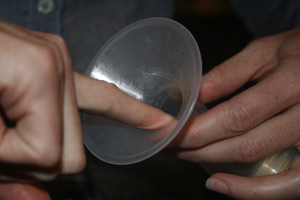Preparing for Nursing

“Ohhhhhhh, my poor, poor boobs”
I’ll never forget standing in the shower a couple of days after giving birth to Lucie and feeling the stream of water hit my chest like a thousand needles.
Lucie did NOT have a good latch and within a day or two had torn up my nipples so very badly (I didn’t get the memo on latching. I blame all of my friends for not telling me).
This doesn’t happen to everyone, but it happens to many first-timers. I even have some mommy friends who went so far as to wear a bikini top in the shower to protect their tattered nips from the force of the water. A BIKINI TOP. IN THA SHOWER. Yeeeeeauh.
The sad truth is that breastfeeding can be hard on your girls in the beginning. But if you are prepared, you’ll get through it like a champ.
Taking Care of Your Nipples (it’s very-freaking-important!)
Your nipples take so much abuse from those early days of learning how to latch properly. Think of the abuse your clutch took when you were learning how to drive a stick shift for the first time. Yeaa. Same thing here.
There are two things I recommend to apply directly to your nipples (recommended and blessed by my lactation consultant, Ami Burnham, LM, RN, IBCL):
1. Earth Mama Angel Baby Nipple Butter – This is an olive oil-based cream that is much less viscous than a lanolin-based cream. Applying thick, honey-like lanolin to sore nipples can in and of itself be painful. Use this instead.
2. Neosporin or Aquaphor – Everyone has Neosporin on hand, right? If there are open sores on your nipples, your #1 goal is to get them to heal – stat! (And fortunately, nipples heal very quickly.)
You can use a little bit of Neosporin without having to wash it off before nursing (why does it matter? Because washing your damaged nipples hurts). If that freaks you out, consult your pediatrician. It works well, trust me!
For pumping, a lanolin-based nipple cream is perfect for smearing around the inside of the breast shield (cone thingy). Like pistons in your car’s engine, your nipples also need to be lubricated while pumping. Think of this as Valvoline for your nipples. I don’t recommend using it directly on your nipples if they are hurting though.

lube up your nipple shields….
If things are going south in the nipple department, you’ll need some Soothies in your life. Soothies are cool, silicone pads that pamper sore (cracked, bleeding, oozing) nipples. When you have tears streaming down your cheeks because you are in so much pain, the ~$10/pair price tag becomes a complete non-issue. I recommend having two pairs on hand. Each pair lasts for several days and is worth its weight in gold.
*Highly recommended: put together your own DIY Breast Care Kit.
Breast Pads
You will also need breast pads to soak up any leaking milk (yes, you WILL leak). Not only is it embarrassing to have milk circles on your shirt, but nipples that don’t dry out properly are at risk for developing thrush, which is essentially a yeast infection of your nipples and breasts. DON’T want.
My favorite solution in the beginning is an old-fashioned disposable breast pad. You can get them from Lansinoh, Medela or Bamboobies. I prefer the Lansinoh nursing pads, but they are all very similar.
A couple of annoying downsides of these disposables are: 1) they come individually wrapped in plastic, so you have to unwrap, peel the sticky tabs off, blah blah. This requires two hands; and 2) they aren’t totally smooth, so you may have that I-stuffed-my-bra-with-Kleenex look. Oh well, you’re nursing. Looking smooth may not be at the top of the priority list.
Engorgement & Blocked Ducts
When your milk first comes in, you will almost certainly experience engorgement. Engorgement doesn’t hurt, per se (unless it’s really bad), but it can be quite uncomfortable. Your breasts may feel like they’re bursting at the seams.
I recommend the ice/heating packs that are circular shaped to fit perfectly on your breasts.
Yet another alternative is wetting and freezing a diaper (a disposable diaper). This makes for an (ironically) perfect booby ice pack.
If you are in it for the long haul, you will almost certainly experience other fun things like blocked ducts. The heating pads are perfect for treating those too.
With caution… you can also use cabbage leaves, which fit very nicely into your bra. Keep them in your fridge and pull one out when you need it. (Note: overuse of cabbage leaves can decrease milk supply. Also, note that cabbage contains sulfa, so if you have an allergy to sulfa, don’t use or ask your doctor.)
Having said all of this, you know what? You’re not going to get torn up nipples because I’m going to teach you how to properly latch. Stay tuned for the Lowdown on Latching edition.
Related:
Hollerrr